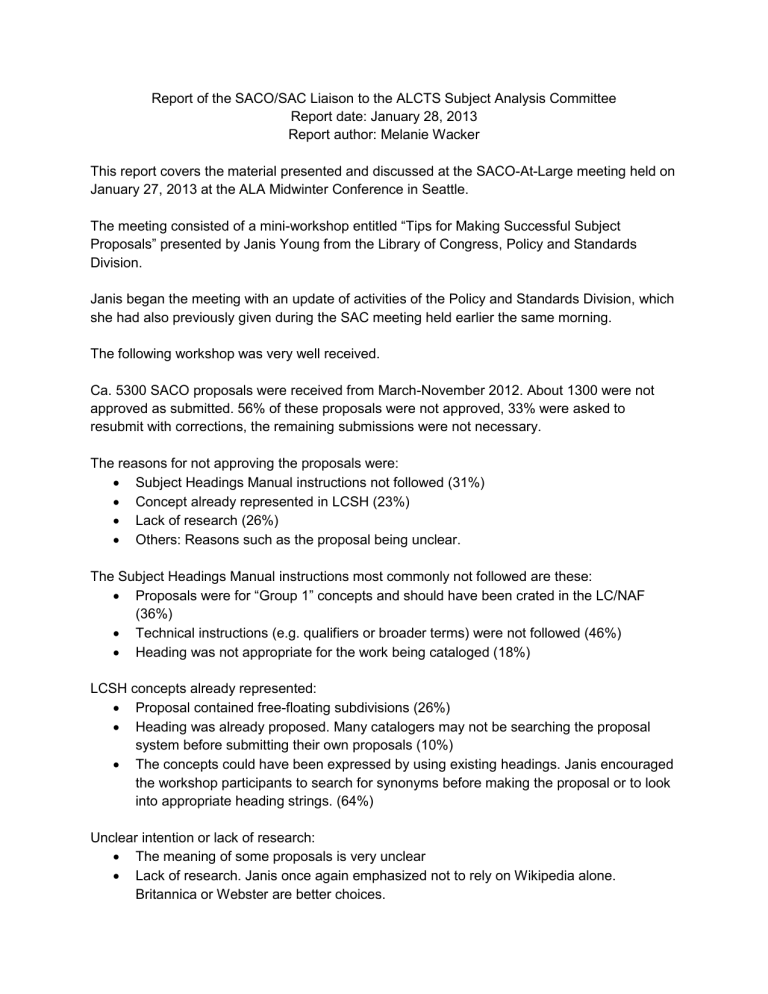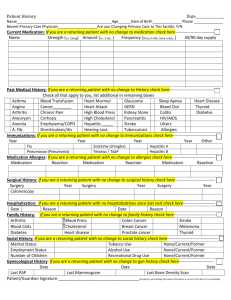SACO_SAC_Liaison_Report_2013_Midwinter

Report of the SACO/SAC Liaison to the ALCTS Subject Analysis Committee
Report date: January 28, 2013
Report author: Melanie Wacker
This report covers the material presented and discussed at the SACO-At-Large meeting held on
January 27, 2013 at the ALA Midwinter Conference in Seattle.
The meeting consisted of a miniworkshop entitled “Tips for Making Successful Subject
Proposals” presented by Janis Young from the Library of Congress, Policy and Standards
Division.
Janis began the meeting with an update of activities of the Policy and Standards Division, which she had also previously given during the SAC meeting held earlier the same morning.
The following workshop was very well received.
Ca. 5300 SACO proposals were received from March-November 2012. About 1300 were not approved as submitted. 56% of these proposals were not approved, 33% were asked to resubmit with corrections, the remaining submissions were not necessary.
The reasons for not approving the proposals were:
Subject Headings Manual instructions not followed (31%)
Concept already represented in LCSH (23%)
Lack of research (26%)
Others: Reasons such as the proposal being unclear.
The Subject Headings Manual instructions most commonly not followed are these:
Proposals were for “Group 1” concepts and should have been crated in the LC/NAF
(36%)
Technical instructions (e.g. qualifiers or broader terms) were not followed (46%)
Heading was not appropriate for the work being cataloged (18%)
LCSH concepts already represented:
Proposal contained free-floating subdivisions (26%)
Heading was already proposed. Many catalogers may not be searching the proposal system before submitting their own proposals (10%)
The concepts could have been expressed by using existing headings. Janis encouraged the workshop participants to search for synonyms before making the proposal or to look into appropriate heading strings. (64%)
Unclear intention or lack of research:
The meaning of some proposals is very unclear
Lack of research. Janis once again emphasized not to rely on Wikipedia alone.
Britannica or Webster are better choices.
Different meaning than intended (e.g. Technology in literature vs. Technology and literature)
A handout with examples of SACO proposals was distributed. These proposals were either not approved or sent back to the cataloger to be resubmitted. The examples were used to illustrate commonly made errors and to give tips on how to avoid them. Some examples triggered interesting discussions, so there was not enough time to look at every single one of them.
Examples discussed:
Record 1
1101# $a France. $b Armee $x History $y Indochinese War, 1946-1954
550 $w g $a Indochinese War, 1946-1954
670 $a Work cat: L'Armee fran~aise dans la guerre d'indochine (1946-1954), c2000.
670 $a LC database, Mar. 21, 2011: $b (subj. hdg.: France. Armee-History-Indochinese
War, 1946-1954)
952 SCM H 120
The subdivision for the war is free-floating provided that the war is already established.
See SHM H 1159 (Military Services)
Recommendation: Search under the broader term. If no other LCSH headings are established following this pattern it might be an indication that it is not necessary to be established.
Record 2
150 $a Thirty Years' War, 1618-1648
450 $a Dreissigjahriger Krieg, 1618-1648 ADD FIELD
550 $w g $a Counter-Reformation
551 $w g $a Europe $x History $y 1517-1648
551 $a Germany $x History $y 1618-1648
670 $a Work cat: Arndt, J. Der Dreissigjahriger Krieg, 1618-1648, 2009.
A proposal was made to add the German language term. Foreign language references are generally not made unless that term is widespread is used in English-language sources.
Record 3
150 $a Korean Chinese
450 $a Chosonjok
450 $a Chaoxianzu
450 $a Joseonjok
550 $w g $a Chinese
550 $a Ethnology $z China
670 $a Work cat.: p'aran kwa kokchol kuringo huimang, 2010: $b t.p. (Chosonjok)
670 $a Han'guk minjok munhwa taebaekkwa sajon, Feb. 6, 2012 $b (Chosol1jok; ethnic
Koreans with Chinese nationality; one of the minority race of China; majorities are living in Yanbian Korean Autonomous Prefecture; keeping cultural and linguistic heritage of
Korea)
670 $a Wikipedia WWW Home Page, Feb. 6, 2012: $b (Joseonjok; Chosonjok; Chaoxianzu; ethnic Koreans with Chinese nationality; Koreans in China include millions of descendants of
Korean immigrants with citizenship of the People's Republic of China, as well as smaller groups of South and North Korean expatriates; one of the 56 ethnicities officially recognized by the
Chinese government; Most of them live in Northeast China, especially in the Yanbian Korean
Autonomous Prefecture)
This proposal was not necessary. The heading string Koreans $z China should have been used instead since ethnic groups are not established for outside the US.
Record 4
151 Sa Sha'arei l:iesed (Jerusalem)
410 1 Sa Jerusalem. Sp Sha'are l:iesed
451 Sa Has'are l:iesed (Jerusalem) [and 4 more UFs]
667 Sa This heading is not valid for use as a geographic subdivision.
670 Sa Work cat: She'arim, 2008: Sb t.p. (Shekhunat Sha'are l:iesed)
670 Sa Encyc. Judaica online, viewed May 23,2012 Sb Jerusalem article (Before the outbreak of World War I the Jewish quarters of Zikhron Moshe (1905), Sha'arei l:iesed, AQavah, Even
Yehoshu'a, Battei Varsha (Warsaw Houses), and RUQamah (all c. 1908) were built.)
670 Sa Wikipedia WWW site, viewed May 23,2012: Sb Sha'arei Hesed (Sha'arei Hesed (also
Sha'arei Chessed) is a neighborhood in central Jerusalem, Israel, bordering Rehavia, Nahlaot and Wolfson Towers. The cornerstone was laide by the Ashkenazi chief rabbi of Jeruslaem,
Rabbi Shmuel Salant, in 1909.)
670 Sa Eiferman Properties, Ltd. WWW site, viewed May 23, 2012: Sb Shaarei Chesed
(Shaarei Chesed is a religious neighborhood at the north edge of Rechavia).
675 Sa GEOnet, May 23, 2012.
952 Sa LC pattern: Sheikh Jarrah (Jeruslalem)
This headings represents a “group 1” concept (a city section) and should be established in the
LC/NAF.
Record 5
150 Sa Group rights
450 Sa Collective rights
550 Sw g Sa Human rights
670 Sa Work cat: Jovanovic, M. Collective rights, 2012.
670 Sa Wikipedia, viewed March 27, 2012: Sb (hdg: Individual and group rights)
670 Sa LC OPAC, viewed March 27, 2012: "Collective rights" -34 hits, 9 in 245 field; "Group rights" -50 hits, 21 in 245 field.
This proposal lacks sufficient research.
Discussion: Google may be used for finding the most current terminology (for number of hits), but not as the justification for a proposal.
After more research, this proposal was approved with a scope note.
Three additional examples (no. 7, Contrastivism (Philosophy), no. 8, Tsakhurs, and no. 10,
Ecovillages) also lacked research or cited sources such as “Internet”.
Record 6
151 Sa Weifen River (China)
451 Sa Weifen He (China)
451 Sa Wei Fen River (China)
551 Sw g Sa Rivers Sz China
670 Sa Work cat: Weifen He liu yu lOng he gui hua yan jiu, 2010.
670 Sa Google, 2012-03-15: Sb hdg. (Wei Fen River)
This proposal lacks research. GeoNet should have been consulted since the GeoNet form of the name is generally preferred for foreign geographic names. The authorized form of the name was eventually determined to be Yufen River (China). However, this proposal illustrated very well how difficult it can be to establish Chinese geographic names based on our commonly used sources: An audience member pointed out that the proposal may actually represent two rivers and not one.
Janis noted that BGN may not always be the most reliable source depending on the country, for example New Zealand.
Record 9
150 $a Hidden organizations
550 $w g $a Organizational sociology
670 $a Work cat: Scott, C.R. Anonymous agencies, backstreet businesses, and covert collectives, 2013: $b ("Contemporary society is characterized in part by various hidden organizations-ranging from clandestine terror networks and secret societies to backalley establishments and largely unknown businesses-that regularly escape our attention amid the focus on more transparent/visible organizations")
670 $a Homepage of Craig R. Scott, Aug. 28, 2012: $b (forthcoming book on hidden organizations; "These more hidden organizations might include secret societies, organized crime, parts of the underground economy, terrorist cells, covert intelligence agencies, anonymous support groups, online hate groups, stigmatized businesses, and others.")
675 $a International encyclopedia of organization studies, c2008; $a International encyclopedia of the social & behavioral sciences, 2001.
This proposal was considered too vague. It is problematic since it is based on terminology used by one author.
Discussion:
The addition of a scope note would have been helpful.
It was noted that having to base a proposal on a CIP can be very difficult.
Record 13
150 $a Returning veterans
450 $a Returnees (Veterans)
450 $a Returning combat veterans
450 $a Returning service members
450 $a Returning soldiers
450 $a Service members, Returning
450 $a Soldiers, Returning
550 $w g $a Veterans
560 $a Work cat: Return [VRJ, 2012: $b (Summary: When a servicewoman returns home following a tour of duty in Iraq, she expects to settle back into her former civilian life.
Instead, she is hit with the difficult realization that the world she left behind is no longer waiting on her.)
670 $a Work cat: When I came home [VRJ, 2006 $b (Summary: A film about homeless veterans in America, especially those who served in Vietnam and those returning from the current war in Iraq. The film reveals the challenges faced by returning combat veterans and the battle many must fight after they come home.)
670 $a Returning from the war zone: a guide for families of military members, 2009, viewed online May 14, 2012: $b p. 1 (returning service members) p. 4 (service members returning from conflicts) p. 5 (post-deployment stage. This is the period after troops have returned home when families must readjust to life together)
670 $a Returning Veterans of America website, May 14, 2012: $b home page (Returning
Veterans of America's (RVA) mission is to help create, build up and support grass roots veteran communities that advance the transitional success and higher education of current returning service members, thereby preparing and supporting them for the next phase of their personal, social, and professional lives)
[several more sources]
680 $i Here are entered works on veterans who have recently returned from military service to civilian life.
This proposal was very well researched and was cause for a lively discussion. One audience member pointed out that the proposal may be redundant because the term “veterans” implies that they must have returned. Janis observed that it is unclear for which timeframe a veteran would be considered a “returning veteran”.
Final discussions:
It is not required to identify BFM, but it is helpful. Janis remarked later that a lot of BFM does not mean anymore that a proposal is less likely to be approved due to automated means of updates.
Workshop attendees were encouraged to e-mail the person in charge of a tentative list if they discovered errors.







